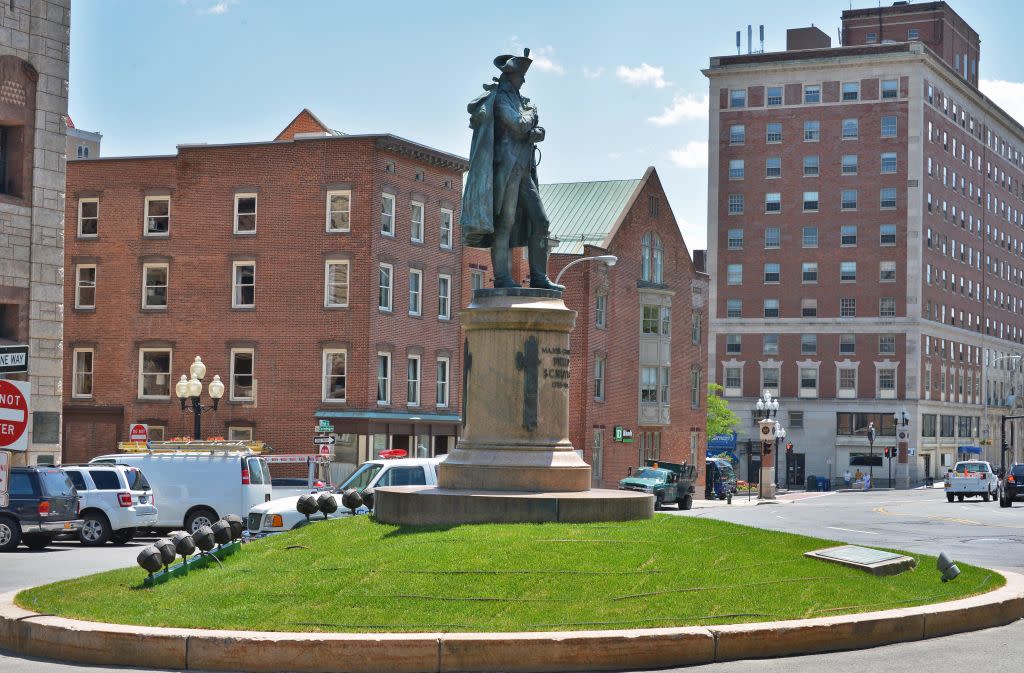There's More to Learn From America's Monuments Debate

New grass surrounds the statue of of Gen. Phillip Schuyler in front of Albany City Hall on June 28, 2012. Credit - John Carl D'Annibale—Albany Times Union via Getty Images
Four years ago, the Black Lives Matter movement reinvigorated public debate about historical monuments in the U.S. Monuments began coming down across the country. From Christopher Columbus in Connecticut to the massive Confederate statues on Monument Avenue in Richmond, Va., public art honoring many historical figures identified with colonialism, slavery, and oppression was either vandalized, relocated, or removed.
At the same time, new monuments have been erected, including works honoring abolitionists Harriet Tubman and Sojourner Truth and activist Barbara Johns, part of the Virginia Civil Rights Memorial. By 2025, another monument to Johns will replace the empty pedestal that once featured Confederate General Robert E. Lee in the U.S. Capitol’s National Statuary Hall. New American heroes — many of them women — have joined the U.S. commemorative landscape.
However, these changes have not gone uncontested, and public opinion is divided. Proponents and opponents operate on different assumptions and frequently talk past one another. This will only intensify with the upcoming 250th commemoration of the American Revolution. But even in a polarized climate, we can choose to approach the debate thoughtfully as an opportunity to learn about the past and its ramifications — both positive and negative — for the present.
Consider the case of Philip Schuyler, a Revolutionary War hero and a politician who was also a slaveholder. In 2023, Albany, N.Y., Mayor Kathy Sheehan ordered the removal of a bronze monument honoring him. Some welcomed the mayor’s decision to remove a statue that reminded them of oppression. But others accused Sheehan of “erasing history” and inappropriately judging past figures by today’s standards.
Read More: Beyond the Founding Fathers: 12 Unsung Figures Who Helped Build America
Who was Schuyler, why was he chosen to symbolize Albany, and why — after almost 100 years — did his monument come under scrutiny?
Schuyler made important contributions to the cause of independence. He was appointed a major general in the Continental Army in 1775. In the face of a British invasion from Canada in the summer of 1777, Schuyler ordered a strategic retreat while creating obstacles to impede the enemy’s passage across difficult terrain. These decisions set the stage for the Patriot victory at the Battles of Saratoga in the fall, which ultimately proved a turning point in the war.
Representing New York at the national level, Schuyler served in the Continental Congress and the U.S. Senate. A Federalist, he promoted both the Constitution and his son-in-law, Alexander Hamilton. His politics might today be characterized as pro-business and anti-populist.
As a land developer and New York’s first surveyor-general, Schuyler foresaw the potential for canals to expand the state’s territory and economy. Like many New Yorkers, he had been frustrated by Britain’s restrictions on taking Native American land. His dealings with Native Americans during and after the war were sometimes fair but sometimes foul.
Additionally, thanks in part to the active role earlier generations of Schuylers had played in the transatlantic slave trade, more than one in seven Albanians in 1790 were enslaved and subject to all the attendant exploitation and insecurity of their status. Philip himself enslaved between nine and 13 persons at any given time. He continued acquiring people until at least 1797 but manumitted some before he died in 1804.
Is it unfairly applying modern values to the 18th century to consider Schuyler’s slaveholding against his military and political achievements? Hardly. There were many Americans during his lifetime who asserted the evil of slavery. A speaker at the 1788 Massachusetts Ratifying Convention declared that George Washington’s “character has sunk 50 per cent” because “he holds those in slavery who have a good right to be free as he has.”
Schuyler is a reminder of how the things we rightly celebrate about that period are intertwined with the things from which we recoil. We continue to grapple with the paradox.
The Schuyler statue in Albany wasn’t erected until more than a century after his death. Approaching the 150th anniversary of the Revolution, Albanians in 1925 pondered how to commemorate the event. The monument reflected that moment.
The deliberations occurred in an era in which the World’s Columbian Exposition, held in Chicago in 1893, had created a taste for monument-making on a grand scale. This bold style — supported by American architects and sculptors who had trained in Europe — meshed with the first reach of American Imperialism in the Pacific and the success of the Spanish-American War.
By the turn of the 20th century, the City Beautiful movement encouraged American communities coast to coast to embrace the Expo’s robust Beaux-Arts aesthetic. The movement emphasized enhancing urban landscapes with European-style parks and monuments, which signaled that Americans were on the move — both at home and abroad.
It was in this context that Albanians rallied around their native son Schuyler. George C. Hawley, a former beer manufacturer, stepped forward to supply an over-life-sized monument to the former general, which he dedicated to his deceased wife, Theodora.
Read More: The U.S. Capitol Is Filled With Racist Depictions of Native Americans. It's Time for Them to Go
The monument, placed in a prominent position in front of City Hall across from the State Capitol, was validated by a "Citizens’ Committee'' composed of the mayor, a judge, a doctor, and a textile factory owner, which accepted the monument on behalf of the city. According to a newspaper account, thousands came out for the dedication. For Hawley, the monument was a personal memorial made public. It also reminded everyone who came within view of City Hall that Albany and its historical figures were worthy of commemoration and, further, that Americans had a lengthy and rich history from which to draw.
However, ideas about the display of American power did not remain static. After the Great Depression and World War II, the interpretation of public spaces began to shift into a less elite mode. Museums and historical sites, including the nearby Schuyler Mansion, could adapt by changing up historically furnished rooms and creating new tours that brought ordinary people into focus. Monuments in bronze lacked such versatility.
In 2022, as part of the broader debates about monuments, five Albany teenagers of color considered what to do about Schuyler, as part of the Young Abolitionist Leadership Institute. They recommended placing the bronze Schuyler in a busy pedestrian space nearby that could be called “The People’s Park.” There, the general would be joined by “modest statues, monuments, and artistic sculptures…which would celebrate and commemorate the contributions of Albany’s diverse and rich heritage.” Although several ideas for Schuyler have been circulated, the monument remains in storage. The stalemate persists.

The Revolutionary War created a new nation that asserted liberty and equality as its founding principles. That itself is worthy of celebration. However, to the extent that actors like Schuyler comported themselves inconsistently with those values — and many of them did — their monuments can be reinterpreted as symbols of persistent resistance to living up to those ideals. Moreover, embodying the Revolution in the bronze statue of one elite revolutionary leaves many important stories, and many groups of people, out of the publicly celebrated American past.
Monuments have something to teach us, even when they are gone. Philip Schuyler in bronze might not appear again in front of Albany’s City Hall, and monuments will continue to go up and come down as Americans continue to ask questions about history, identity, and shared memory. But the upcoming 250th anniversary of the founding of the U.S. is a moment not only to remember revolutionary courage and ideals, but also to confront failures to live up to them. If we take the time, we can use history to understand that the debate around monuments is more complicated — and potentially more useful — than we think. Although Google Maps tells us the “Philip Schuyler Statue” is “permanently closed,” it is still open for conversation.
Laura A. Macaluso is a researcher and writer working on monuments, museums, and material culture. She is the editor of Monument Culture: International Perspectives on the Future of Monuments in a Changing World. Karim M. Tiro is a professor of history at Xavier University. He is the author of The People of the Standing Stone: The Oneida Nation from the Revolution through the Era of Removal. Both are members of the working group Historians for 2026.
The Road to 250 series is a collaboration between Made by History and Historians for 2026, a group of early Americanists devoted to shaping an accurate, inclusive, and just public memory of the American Founding for the upcoming 250th anniversary.
Made by History takes readers beyond the headlines with articles written and edited by professional historians. Learn more about Made by History at TIME here. Opinions expressed do not necessarily reflect the views of TIME editors.
Write to Made by History at madebyhistory@time.com.

 Yahoo News
Yahoo News 
